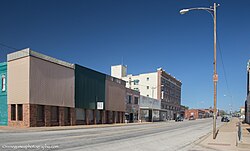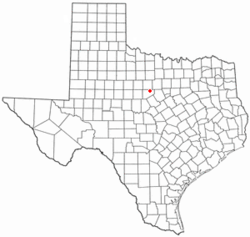City in Texas, United States
| Ranger, Texas | |
|---|---|
| City | |
 Downtown Ranger, Texas Downtown Ranger, Texas | |
 Location of Ranger, Texas Location of Ranger, Texas | |
 | |
| Coordinates: 32°28′09″N 98°40′31″W / 32.46917°N 98.67528°W / 32.46917; -98.67528 | |
| Country | United States |
| State | Texas |
| County | Eastland |
| Area | |
| • Total | 7.13 sq mi (18.46 km) |
| • Land | 7.00 sq mi (18.12 km) |
| • Water | 0.13 sq mi (0.34 km) |
| Elevation | 1,427 ft (435 m) |
| Population | |
| • Total | 2,300 |
| • Density | 320/sq mi (120/km) |
| Time zone | UTC-6 (Central (CST)) |
| • Summer (DST) | UTC-5 (CDT) |
| ZIP code | 76470 |
| Area code | 254 |
| FIPS code | 48-60632 |
| GNIS feature ID | 2411519 |
Ranger is a city in Eastland County, Texas, United States. Its population was 2,300 at the 2020 census. Ranger College, a community college, is the second-largest employer in the community.
During the 1920s, Ranger, like nearby Cisco, Eastland, and Desdemona, was a petroleum boomtown.
History
The Texas Pacific Coal Company of Thurber drilled a gas well north of Ranger in August 1917, after town civic leaders offered acreage in return for four test wells. Then on October 11, 1917, the McClesky well, one mile southwest of Ranger, produced oil at 1200 BOPD. Production came from the Strawn Formation sandstones at 1,300 to 2,000 feet (400 to 610 m), the Smithwick Shale, and the Marble Falls Formation limestone at 3,200 to 3,400 feet (980 to 1,040 m) feet. The Ranger Oil Field production peaked in July 1919 at 80,000 BOPD. The oil boom brought many seeking jobs, including farm boys and demobilized veterans.
Geography
Ranger is located in northeastern Eastland County. Interstate 20 passes south and east of the city, with access from Exits 349, 351, 352, and 354. I-20 leads east 85 miles (137 km) to Fort Worth and west 65 miles (105 km) to Abilene. Eastland, the county seat, is 10 miles (16 km) to the west.
According to the United States Census Bureau, the city of Ranger has a total area of 7.1 square miles (18.5 km), of which 0.1 square miles (0.3 km), or 1.83%, is covered by water.
Ranger Antique Airfield dates back to 1911. Pilot Amelia Earhart landed at the field in 1931 in her Pitcairn Autogyro. Ranger Airfield has two grass runways: 1/19 – 3400 x 80 ft and 17/35; 1950 x 60 ft.
Climate
The climate in this area is characterized by hot, humid summers and generally mild to cool winters. According to the Köppen climate classification, Ranger has a humid subtropical climate, Cfa on climate maps.
Demographics
| Census | Pop. | Note | %± |
|---|---|---|---|
| 1920 | 16,205 | — | |
| 1930 | 6,208 | −61.7% | |
| 1940 | 4,553 | −26.7% | |
| 1950 | 3,989 | −12.4% | |
| 1960 | 3,313 | −16.9% | |
| 1970 | 3,094 | −6.6% | |
| 1980 | 3,142 | 1.6% | |
| 1990 | 2,803 | −10.8% | |
| 2000 | 2,584 | −7.8% | |
| 2010 | 2,468 | −4.5% | |
| 2020 | 2,300 | −6.8% | |
| U.S. Decennial Census | |||
2020 census
| Race | Number | Percentage |
|---|---|---|
| White (NH) | 1,633 | 71.0% |
| Black or African American (NH) | 103 | 4.48% |
| Native American or Alaska Native (NH) | 23 | 1.0% |
| Asian (NH) | 22 | 0.96% |
| Some Other Race (NH) | 4 | 0.17% |
| Mixed/Multi-Racial (NH) | 38 | 1.65% |
| Hispanic or Latino | 477 | 20.74% |
| Total | 2,300 |
As of the 2020 United States census, there were 2,300 people, 1,017 households, and 516 families residing in the city.
2000 census
As of the census of 2000, 2,584 people, 989 households, and 616 families resided in the city. The population density was 369.0 inhabitants per square mile (142.5/km). The 1,214 housing units averaged 173.4 per square mile (67.0/km). The racial makeup of the city was 84.83% White, 6.73% African American, 0.66% Native American, 0.43% Asian, 5.65% from other races, and 1.70% from two or more races. Hispanics or Latinos of any race were 13.51% of the population.
Of the 989 households, 28.0% had children under the age of 18 living with them, 43.7% were married couples living together, 14.7% had a female householder with no husband present, and 37.7% were not families. About 34.5% of all households were made up of individuals, and 18.7% had someone living alone who was 65 years of age or older. The average household size was 2.33 and the average family size was 3.00.
In the city, the age distribution was 22.7% under 18, 17.4% from 18 to 24, 20.9% from 25 to 44, 19.4% from 45 to 64, and 19.7% who were 65 or older. The median age was 36 years. For every 100 females, there were 97.1 males. For every 100 females age 18 and over, there were 93.8 males.
The median income for a household in the city was $22,500, and for a family was $28,255. Males had a median income of $24,333 versus $15,946 for females. The per capita income for the city was $11,698. About 14.4% of families and 18.3% of the population were below the poverty line, including 19.1% of those under age 18 and 17.8% of those age 65 or over.
Education
The city is served by the Ranger Independent School District and home to the Ranger High School Bulldogs, 1953 state football champions (Class 1A). The city is also home to Ranger College.
Notable people
- Stephen Arterburn, Evangelical Christian author and spokesman
- Bobby Cross, American football player
- Buster Mills, baseball player
- Ted Neeley, actor
- Bob Smith, American football player
- Eve Southern, actress
- Walter Prescott Webb, eminent Texas, Western and Great Plains historian
Photo gallery
-
 Ranger Train Depot
Ranger Train Depot
-
 Terrell Building
Terrell Building
-
 City Hall
City Hall
-
 Auditorium
Auditorium
-
 United States Post Office
United States Post Office
-
 Halbert Building
Halbert Building
-
 Lone Star Theater
Lone Star Theater
-
 Downtown Ranger
Downtown Ranger
-
 Downtown Ranger
Downtown Ranger
-
 Downtown Ranger
Downtown Ranger
-
 St.Rita's Catholic Church
St.Rita's Catholic Church
-
 First Baptist Church
First Baptist Church
-
 Oil-field boom town of Ranger in 1919
Oil-field boom town of Ranger in 1919
References
- "2019 U.S. Gazetteer Files". United States Census Bureau. Retrieved August 7, 2020.
- ^ U.S. Geological Survey Geographic Names Information System: Ranger, Texas
- ^ "U.S. Census website". United States Census Bureau. Retrieved January 31, 2008.
- ^ "Explore Census Data". data.census.gov. Retrieved May 21, 2022.
- "H. Allen Anderson, "Wichita Falls and Southern Railroad"". tshaonline.org. Retrieved April 19, 2013.
- Reeves, Frank (1922). "GEOLOGY OF THE RANGER OIL FIELD, TEXAS, in Contributions to Economic Geology, Part II" (PDF). USGS. pp. 111–170. Retrieved August 22, 2020.
- Olien, Diana; Olien, Roger (2002). Oil in Texas, The Gusher Age, 1895-1945. Austin: University of Texas Press. pp. 79–83. ISBN 0292760566.
- "Geographic Identifiers: 2010 Census Summary File 1 (G001): Ranger city, Texas". American Factfinder. U.S. Census Bureau. Archived from the original on February 13, 2020. Retrieved March 24, 2016.
- Climate Summary for Ranger, Texas
- "Census of Population and Housing". Census.gov. Retrieved June 4, 2015.
- https://www.census.gov/
- "About the Hispanic Population and its Origin". www.census.gov. Retrieved May 18, 2022.
- Note: the US Census treats Hispanic/Latino as an ethnic category. This table excludes Latinos from the racial categories and assigns them to a separate category. Hispanics/Latinos can be of any race.
| Municipalities and communities of Eastland County, Texas, United States | ||
|---|---|---|
| County seat: Eastland | ||
| Cities |  | |
| Towns | ||
| Unincorporated communities | ||
| Ghost town | ||